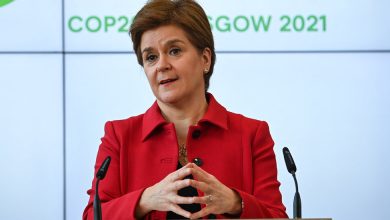Corporate Climate Pledges Often Ignore a Key Component: Supply Chains

For nearly 30 years, the pharmaceutical giant Bristol Myers Squibb has proclaimed it’s been setting and meeting ambitious targets around energy and greenhouse gas emissions. These days, those goals include being “carbon neutral” by 2040.
The equipment manufacturer Caterpillar, Texas Instruments, Exxon Mobil and the Walt Disney Company have all made similar claims about the sustainability of their operations and have set objectives to reduce emissions.
But something is missing from these lofty corporate goals: any accounting of significant emissions from their supply chains or waste from their products. For some companies, those can total as much as 95 percent of their overall contributions to greenhouse gases.
A closer look at corporate America’s claims that it’s accelerating efforts to tackle the climate crisis — made in marketing and investor presentations — reveals that many of these assertions remain quite limited and fail to make a dent in the largest source of carbon emissions: the global supply chains that power the modern economy and have become dinner-table conversation amid massive disruptions this year.
Emissions from supply chains and waste are “hugely important,” said Tom Cumberlege, an associate director at The Carbon Trust, which works with companies, governments and others to create carbon-reducing plans. “Any company that isn’t measuring the full value chain is not coming to grips with a key piece of their impact.”
Corporations are again highlighting their role as responsible environmental stewards as the United Nations’ annual global warming conference in Glasgow begins. Heads of state, diplomats and activists are meeting in person to set new targets for cutting emissions from fossil fuels in the hopes of preventing the average global temperature from rising more than 1.5 degrees Celsius compared with levels before the Industrial Revolution. Failure to do so could lead to catastrophic consequences from global warming, scientists warn.
But despite their pledges to help, many companies are still taking steps that reduce carbon in the most minimal ways. These include installing solar panels at headquarters, designing more energy efficient stores, and tracking commuting and business travel by their employees.
But emissions from the factories that make the sneakers sold on e-commerce websites or from the farms that produce the meat and milk sold on grocery shelves continue to grow in some cases.
That poses challenges to consumers who want to spend money on sustainable goods and services and to investors who increasingly are looking to finance companies that are helping, not hurting, the planet.
Angel Hsu, an assistant professor at the University of North Carolina and founder of the Data-Driven EnviroLab, created a database using corporate climate disclosures and other sources and found 1,858 companies out of 2,000 have either pledged or committed to become net zero. But only 210 of the companies reported emissions from supply chains or consumer waste.
In another analysis, Professor Hsu found that roughly two-thirds of the companies that said they were on track to meet emission-reduction targets set for 2030 had set low or unambitious targets. “I’m generally skeptical of a company that says it has achieved or overachieved its targets at this point,” Professor Hsu said.
Amazon said emissions from indirect sources, for example, increased 15 percent in 2020 from the previous year. The company has pointed out that when its emissions are measured relative to its booming sales, its carbon footprint has been decreasing. But some climate experts say this calculation, called carbon intensity, obscures the fact that the company is still generating an increasing amount of carbon.
“The planet doesn’t care about carbon intensity,” said Roland Geyer, a professor of industrial ecology at the University of California, Santa Barbara, “The climate is being hurt by absolute emissions.”
Walmart said it is difficult to accurately measure carbon contributions from its many suppliers, and the company does not disclose whether total emissions in its supply chain have been increasing or declining each year. The company said about 95 percent of the carbon emissions related to its business comes from its supply chain.
The retailer said that it has set a voluntary emissions reduction goal for its suppliers and that about 1,500 companies have reported progress toward the goal.
But Walmart has stopped short of requiring suppliers to reduce emissions. Rather if they report certain levels of progress, Walmart awards them with labels such as “Giga-Gurus” and “Sparking Change Suppliers”
“We have internal dashboards showing which suppliers are participating and who the leaders are,” said Zach Freeze, a senior director of strategic initiatives and sustainability at Walmart. “Merchants are competitive. They want to be on the leaderboard.”
An increasing number of companies are trying to quantify the problem. The number of companies voluntarily submitting their emission reports and reduction goals to the Science Based Targets initiative, a nonprofit that assesses and approves company targets, doubled this year to more than 2,000, said Alberto Carrillo Pineda, the co-founder of the initiative.
Last week, the organization released the criteria companies will have to meet to reach “net zero” goals later, and they include steep reductions in emissions from supply chains. But Mr. Carrillo Pineda noted that the companies provide the data voluntarily, so “there is no full guarantee that a company is always including every emission.”
Eventually, companies may be forced to do so. The Securities and Exchange Commission is weighing whether to require more robust disclosures from companies about their emissions, citing increased demand for more transparency from investors.
In July, the S.E.C.’s chairman, Gary Gensler, said he had asked his staff for a recommendation on whether to start requiring companies to reveal emissions generated by their suppliers to give investors a full accounting of their carbon footprint.
“Companies could announce plans to be ‘net zero’ but not provide any information that stands behind that claim,” Mr. Gensler said in a speech this summer.
But forcing companies to more fully disclose their carbon footprints is only part of the challenge. Meaningfully reducing emissions in their supply chains could conflict fundamentally with their business models.
Take the retail industry. The more products retailers sell, the more emissions they generate from the production and transportation of those products. Target said sales during the pandemic — which grew by $15 billion in 2020, greater than its total sales growth over the prior 11 years — contributed to a 16.5 percent increase in emissions from its supply chain.
“The historic challenges and unique retail needs driven by the dynamics of 2020 had an undeniable impact on our business as we met increased consumer demand,” Target said in its most recent sustainability report. “In turn, we also saw an increased impact of our emissions.”
Still, Target says it is keeping its pledge to reach net zero emissions, including its supply chain, by 2040.
“These increases do not deter us from our net zero commitment, nor from our work to continue creating strategies to avoid, reduce and remove emissions from our value chain,” the company said
Professor Geyer said the pressure for companies to constantly grow their profits and sales make such pledges unrealistic. He recently wrote a book, “The Business of Less,” in which he argued that companies need to pull back on their growth or make other radical changes to their businesses if they want to truly help the climate. Such transformations no longer seem impossible, as the auto industry is demonstrating with its switch to electric vehicles.
“The big myth in the corporate sustainability world is the idea of ‘win-win’ — that a company can maximize profits and still stay environmentally friendly,” Professor Geyer said in an interview. “We have 30 years of data that we can look at and say that doesn’t work.”




